Psychobiotics is a term you may not have heard of. You likely have heard of at least 3 out of the other 5.
Is it just me or does it seem like things become more complicated the longer we go about our research? New terms pop up, and it all feels a little overwhelming.
You know, this is why I am highly committed to A Gutsy Girl. I’m trying to take all the details and condense them into bite-sized, digestible pieces of information.
I don’t want you to feel the overwhelm; just reap the benefits of what it all means for your own journey.
Psychobiotics {+ 5 other ‘biotics to know}
Click HERE to save this post for later.
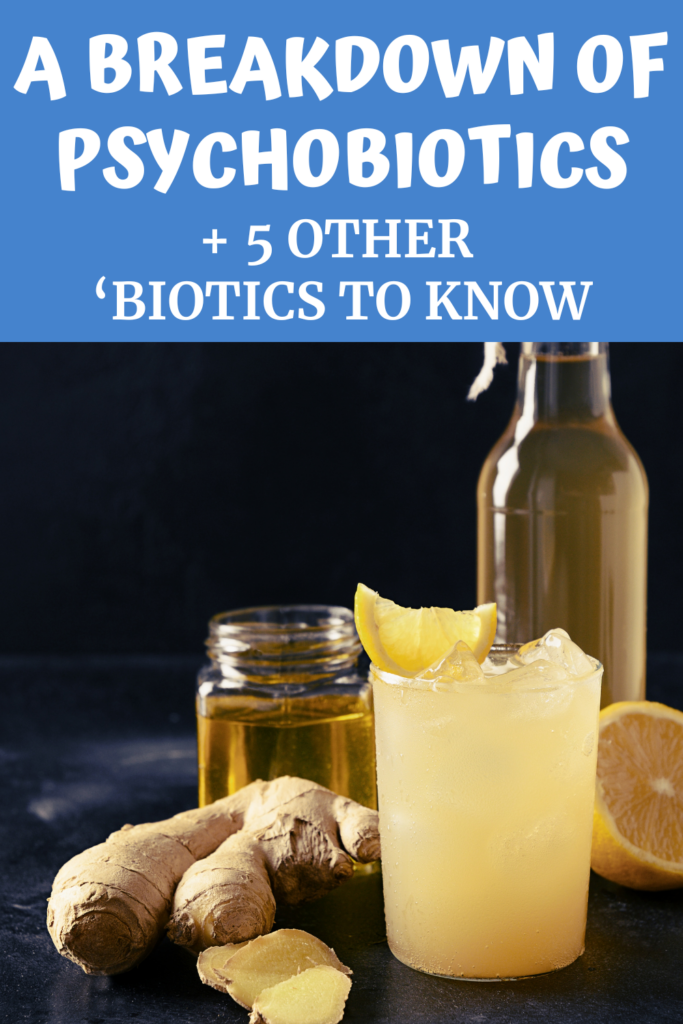
So here’s the deal, you might not know it but there are so many ‘biotics out there.
Here is the list of 6:
- prebiotics
- antibiotics
- probiotics
- synbiotics
- postbiotics
- psychobiotics
I anticipate this list will grow, somehow.
By now you have heard about and are likely quite familiar with prebiotics, probiotics, and antibiotics.
My goal today is to break all 6 ‘biotics down and out for you.
When Should I Take These ‘Biotics?
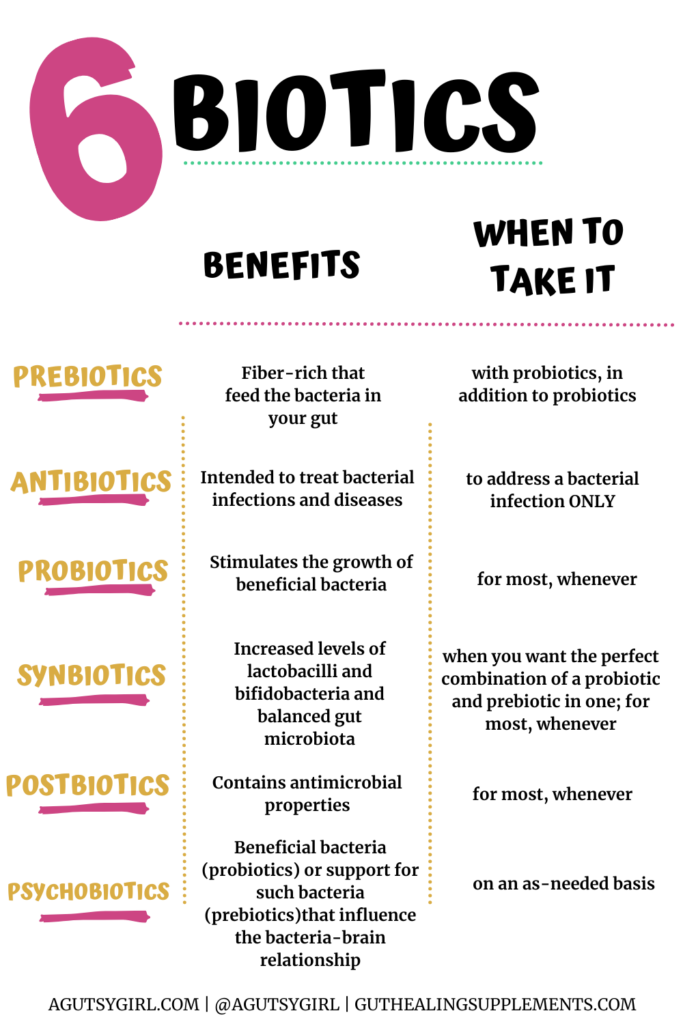
Before we dive in, just a quick discussion around when you should take the various 6 ‘biotics.
The best thing you can do is work with your medical practitioner to determine which of them (if any) will benefit you. Beyond that, here is a general outline for when they are taken:
- Prebiotics: with probiotics, in addition to probiotics
- Antibiotics: to address a bacterial infection only
- Probiotics: for most, whenever
- Synbiotics: when you want the perfect combination of a probiotic and prebiotic in one; for most, whenever
- Postbiotics: for most, whenever
- Psychobiotics: on an as-needed basis, research different probiotic strains for your particular condition
Keep in mind with all of the above that different foods, forms, strains, species, etc. will be necessary depending on the person. While one probiotic strain and species might work well for your friend, another may work better for you.
I wish I could tell you this was an easy, clear-cut path. It’s not, though.
The way to keep track of what’s working and what’s not is to return to these two things, every single day:
Prebiotics
What is a prebiotic and how is it different from a probiotic?
Pre = before
Simply put, prebiotics are fiber-rich foods that feed the bacteria in your gut. Prebiotics are created from other bacteria your body has already created.
Probiotics cannot survive without food, which is where prebiotics come in.
Think of probiotics as the plants and prebiotics as the fertilizer.
Here are three things to know about prebiotics:
- They are not absorbed in your upper GI tract
- Prebiotics resist the acidity of the stomach
- They have the ability to be fermented by intestinal bacteria
Prebiotics are the fibers that your body can’t digest, but that the gut loves.
Other than feeding probiotics, prebiotics offer other body benefits, including:
- Increase calcium absorption, which can lead to improved bone density
- Increase magnesium absorption
- Have a positive effects on the immune system
- Assist with lowering cholesterol
- Helping improve insulin sensitivity
- Support with weight loss
- Help with leaky gut
Here are two ways prebiotics benefit good bacteria exclusively:
- Prebiotics can lower the pH of your intestines by feeding the bacteria that produces lactic acid. A lower pH wards off pathogens, which tends to grow in higher pH environments.
- When good bacteria levels grow, they produce antibacterial molecules that ward off bad bacteria.
Similar to the probiotics, we can get prebiotics both from food sources and through supplementation.
These foods make great prebiotics since they contain fiber that can make its way through the GI tract, feeding the probiotics there.
- Tomatoes
- Artichokes
- Onions
- Chicory root
- Asparagus
- Garlic
- Leeks
- Dandelion greens
- Bananas
- Kiwifruit
- Psyllium
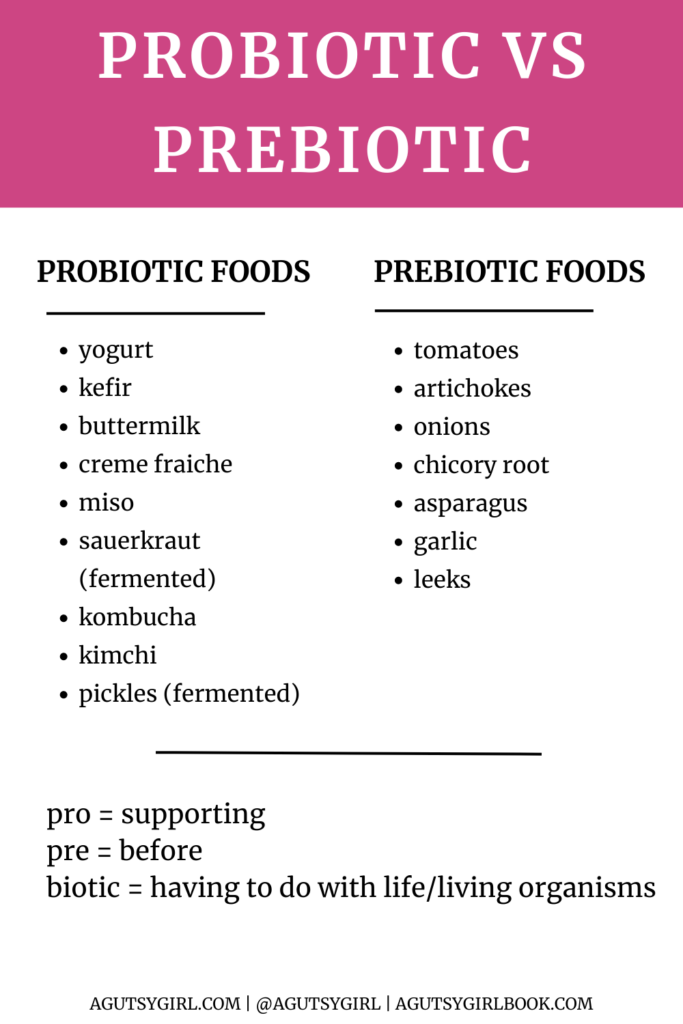
My top THREE choices for prebiotic supplements are:
- Just Thrive Precision PREbiotic (pill version)
- Just Thrive Precision PREbiotic (powder version)
- MegaPre Precision Prebiotic (powder version)
Just Thrive Precision PREbiotic
The Just Thrive Precision PREbiotics contains these 3 clinically proven strains of PREbiotics (which are natural ingredients, by the way):
- Fructooligosaccharides (Non-GMO green and gold kiwifruit)
- Xylooligosaccharides (Non-GMO corn cob)
- Galactooligosaccharides (rBST-free cow’s milk)
These ingredients are included because they have been shown to:
- Only fuel the good bacteria (and completely ignore the pathogens)
- Soothe gastrointestinal (GI) distress, such as gas and bloating (compared to other prebiotic fibers that can cause MORE gastrointestinal distress)
- Drive the healthy growth of your beneficial bacterial populations… In fact, when you combine Precision PREbiotic with Just Thrive Probiotic, you can double the amount of “good guys” in your gut.
The “smart” fibers in Precision PREbiotic can help you unlock your health potential.
Here are several reasons why this is one of my top picks:
- Nourishes ONLY your good gut bacteria*
- Can more than DOUBLE your population of good bacteria*
- Provides crucial digestive and immune support*
- Supports bowel regularity
- Reduces flatulence, bloating and abdominal pain
- Drives butyrate production (butyrate is the primary fuel for your natural killer immune cells)*
- Increases nutrient absorption*
- Encourages feelings of fullness for easy weight management*
- Supports healthy sugar metabolism*
- Microbiologist-formulated, evidence-based, and safe*
- Non-GMO and made WITHOUT gluten, soy, sugar, and nuts
- The 3 super fibers in Precision PREbiotic can be easily taken in a daily capsule or you can mix up a batch of Precision PREbiotic drink mix in the morning and take sips throughout the day. Either way, your good bacteria will get all the fuel it needs to power your immune system and help you feel good around the clock.
If you still want more, learn all about prebiotics HERE.
Antibiotics
Anti = against
You may have heard that antibiotics are counterintuitive to optimal gut health.
But it’s important to understand the role of antibiotics in the gut. Antibiotics are a category of drug that is prescribed to either kill bacteria or prevent bacteria from reproducing.
Antibiotics can be useful and even life-saving. But overuse of antibiotics can wreak havoc on the gut.
Overuse of antibiotics has created some issues, including resistance (reduced effectiveness), overprescribing antibiotics when they’re not needed, and gut-related side effects.
According to research printed in Pharmacy & Therapeutics, a peer-reviewed journal,
The modern era of antibiotics started with the discovery of penicillin in 1928. Penicillin was successful in controlling bacterial infections among World War II soldiers. Problems began after that, when resistance developed with Penicillin and then eventually, with other antibiotics as well.
So when are antibiotics the right choice? Antibiotics are intended to treat bacterial infections and diseases, not viral ones.
Some common bacterial infections include:
- Strep throat
- Pneumonia
- bacterial skin infections
- foodborne bacterial infections (like e.coli)
- UTI
- bronchitis
- SIBO – yes! – small intestinal bacterial overgrowth
If you want even more, read Side Effects of Antibiotics and Rebuilding the Gut.
Probiotics
What’s the opposite of anti? Pro, of course.
Probably the number 1 question I’m asked is,
What probiotic do you recommend?
Let me first make it clear that this is a difficult question to answer, as the type of probiotic that is beneficial for one person might be different for another. It’s individualized, similar to your overall gut-healing journey.
Pro = for
A probiotic stimulates the growth of beneficial bacteria.
Simply put, a probiotic is “good bacteria.”
There are two main ways we get probiotics; via probiotic supplement and/or by consuming probiotic-rich foods, such as:
- Yogurt naturally contains probiotics, but some manufacturers add additional strains, such as L. acidophilus
- Miso is a fermented soy-based condiment. It makes an awesome flavor addition to soup
- Fermented vegetables, such as sauerkraut, pickles and kimchi, especially those that are homemade or sold refrigerated
- Kombucha is fermented tea
- Kefir is a fermented thick drink, similar to yogurt, but made by inoculating cow, sheep or or goat milk with kefir grain
- Buttermilk is fermented milk. Traditionally, it was made from the liquid left behind after churning butter, but most modern buttermilk is cultured
- Creme fraiche is a thick dairy product, similar to sour cream
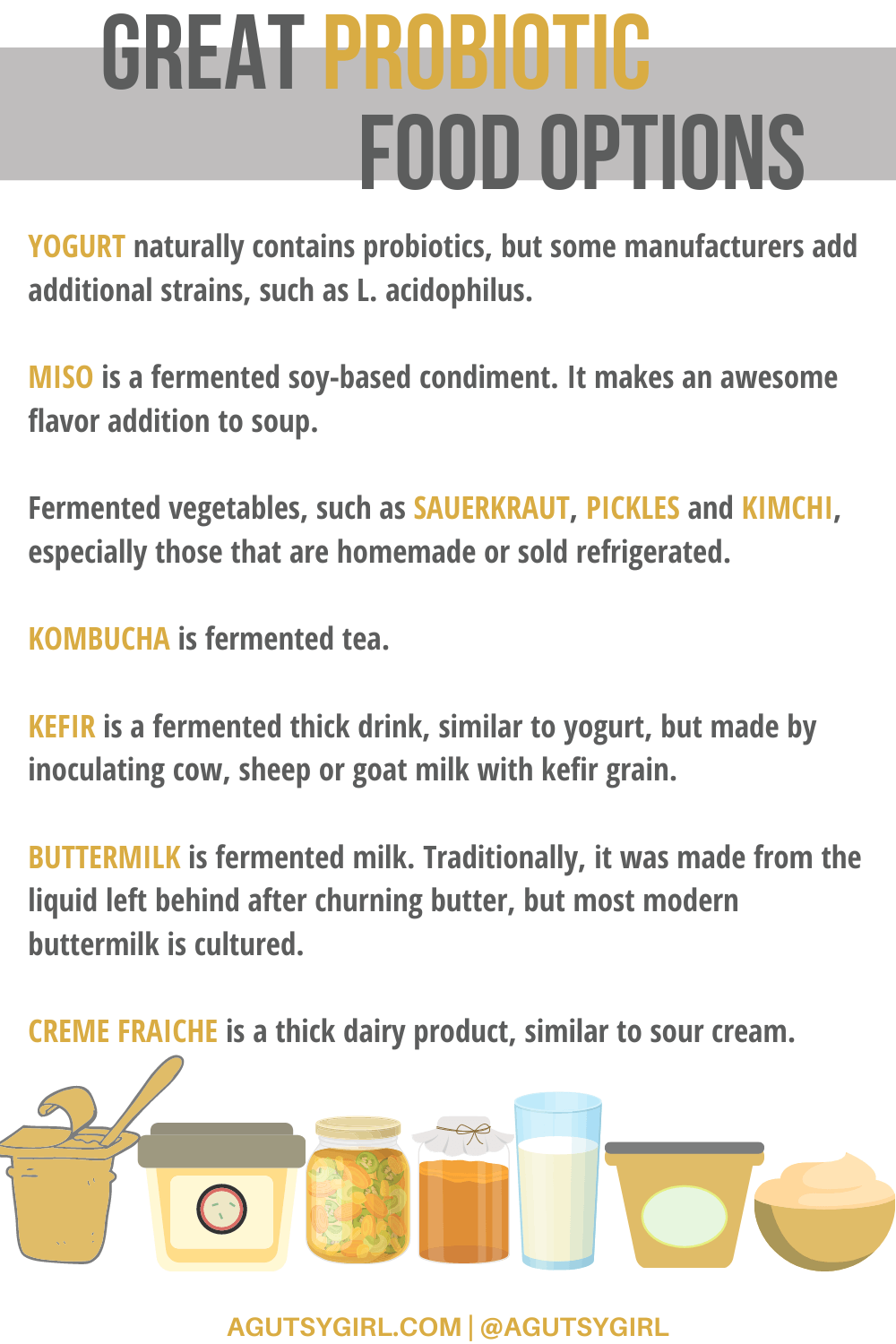
Probiotic Supplements
The other way to get more probiotics is by taking a probiotic supplement.
When looking at a probiotic label, you will either see two or three words that describe the type of probiotic.
These two or three words include some or all of the following: genus, species and strain.
- An example of two: Lactobacillus (genus) acidophilus (species)
- An example of three: Bacillus (genus) subtilis (species) HU58 (strain)
When you see two words, that means the manufacturer has listed only the species, not the strain, of probiotic being used. And when you see three words, such as Bacillus subtilis HU58, the manufacturer has listed the specific strain of probiotic used.
I personally use, as does my whole family, Just Thrive probiotics. Because I exclusively use them, you can always use my code AGUTSYGIRL at checkout HERE to save 15%.
Because I have written about probiotics exhaustively, I won’t recreate this wheel. Instead, here are 3 top probiotic articles to check out today if you’re wanting more:

Synbiotics
We are now getting into the “biotics” that you may not have heard of yet. First up, synbiotics.
Syn = together
Think of a synbiotic as a combination of a probiotic and a prebiotic. Synbiotics both supply and feed gut bacteria. They were created to overcome possible survival difficulties for probiotics.
According to the Journal of Food Science Technology,
a synbiotic product beneficially affects the host in improving the survival and implantation of live microbial dietary supplements in the gastrointestinal tract by selectively stimulating the growth and/or activating the metabolism of one or a limited number of health-promoting bacteria.
The health benefits of synbiotics include:
- Increased levels of lactobacilli and bifidobacteria and balanced gut microbiota
- Improved liver function in cirrhotic patients
- Improved immunomodulation
- Prevention of bacterial translocation and reduced incidences of nosocomial infections in surgical patients
So how do we get synbiotics? There are two basic ways: food combining or as a supplement. Isn’t this always the case?!
Synbiotic Food Combining
Since a synbiotic is a combination of a probiotic and prebiotic, you can simulate a synbiotic experience by eating a probiotic-containing food and a prebiotic-containing food together.
Try these synbiotic combinations
- Yogurt (probiotic) topped with bananas (prebiotic)
- Miso-based broth soup (probiotic) with asparagus and leeks (prebiotics)
- Kimchi (probiotic) over top of a Buddha/grain bowl (prebiotic)

Another route to try synbiotics is as a supplement.
Here are two I recommend:
- Seed Daily Synbiotic
- Gut Power Drinks (if you use code AGUTSYGIRL at checkout you’ll save 15%)
Postbiotics
The next class of “biotics” to cover are postbiotics.
Postbiotics are probably the least researched of the biotics.
But there are a few things we know.
Post = after
Postbiotics are the byproduct of bacterial fermentation in the intestines.
Prebiotics feed probiotics, which creates postbiotics, which promote prebiotics. The cycle continues, creating a positive effect on the human gut environment.
Since postbiotics are still being studied, there is not a lot of published research about them.
Here are some possible benefits of postbiotics:
- May help lower blood sugar
- Supports probiotics
- May be a treatment for diarrhea
- Contains antimicrobial properties
- Supports immunity in infants
- Reduces inflammation
Since a postbiotic is something “leftover” from the goods already created, you can reap these possible benefits by including more fermented foods and foods that contain live bacteria (ie. homemade yogurt, tempeh, sauerkraut) in your diet.
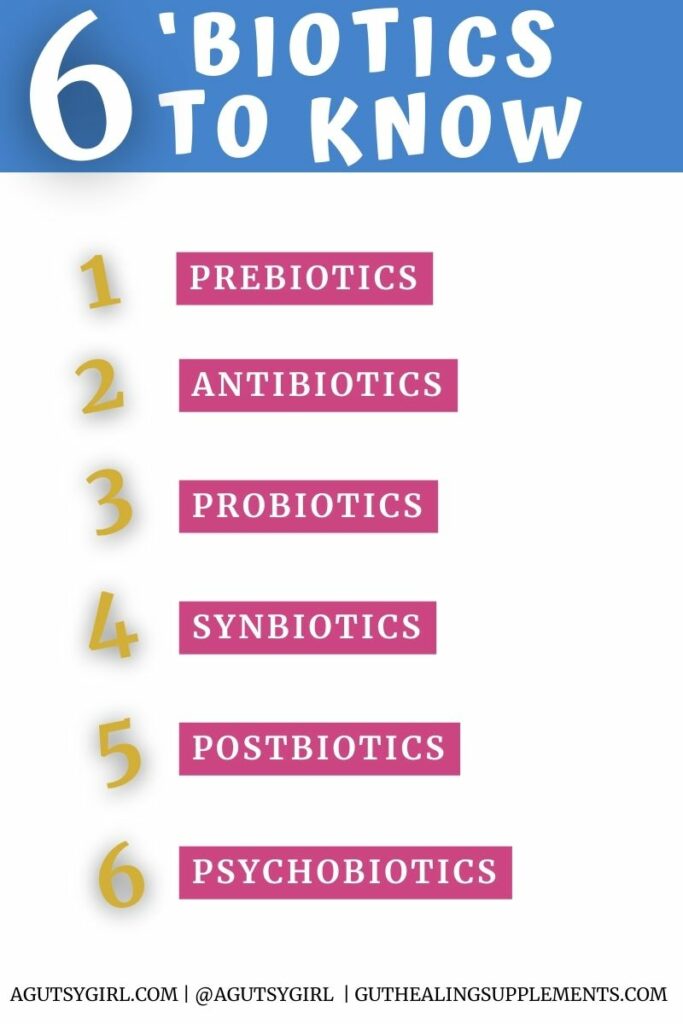
Psychobiotics
And last, but certainly not least, psychobiotics.
The NIH defines psychobiotics as such,
Psychobiotics are beneficial bacteria (probiotics) or support for such bacteria (prebiotics) that influence bacteria–brain relationships.
A psychobiotic isn’t truly a new idea. It’s a new term, but its roots first came from a probiotic, then expanded to include prebiotics. Therefore, I can’t help but ask the question,
Isn’t a psychobiotic just a synbiotic?
Anyways, my question is neither here nor there.
The reason psychobiotics are starting to get attention is due to the research increasing and correlation magnifying between the gut-brain axis.
Gut-Brain Axis
We know that our gut bacteria communicates directly with the brain via the nervous system; it is a bidirectional relationship.
People with gastrointestinal disorders have higher-than-average rates of neuropsychiatric problems such as bipolar disorder and depression, she notes, while people with schizophrenia often have blood markers suggestive of gastrointestinal inflammation. People with autism spectrum disorder, too, have higher rates of gastrointestinal problems than the general population.
Thus, the term psychobiotic is meant to align with the gut-brain connection.
In fact, this reminds me of the new book by Dr. Natasha Campbell-McBride I’m reading, Gut and Physiology Syndrome.
If you recall, Dr. Natasha first came out with Gut and Psychology Syndrome. This is the sequel perhaps. The difference lies within the illness manifested.
- Psychology = learning disabilities and mental disorders
- Physiology = chronic physical conditions
Perhaps this is similar to how we distinguish between a synbiotic and psychobiotic? Just throwing that out there.
Anyways, various species of probiotics (and prebiotics) as they relate to the gut-brain connection are currently being studied.
You can see various studies HERE.
Bifidobacterium longum 1714™
There is a probiotic strain, Bifidobacterium longum 1714™, that is currently the most heavily researched and scientifically verified strain available.
A study conducted by the NIH states,
What is Known
✓ Accumulating evidence indicates that the gut microbiota communicates with the CNS, possibly through neural, endocrine, and immune pathways, and influences brain function.
✓ Effects of probiotics on the CNS functions are strain specific.
✓ B. longum 1714™ has been shown to reduce stress-related behaviors in preclinical studies and improve stress responses and cognitive function in healthy volunteers.
And I think that because of this study and more, my friends at Just Thrive came out with the Just Calm product which helps with stress management and boost mood.
Here are some things about Just Calm:
- The only stress/mood product to combine proprietary BL 1714™ with brain nourishing B vitamins
- Microbiologist-formulated and pharmaceutical grade
- Vegan, Paleo, and Keto-Friendly
- Free of wheat, dairy, soy, sugar, salt, nuts, and non-GMO

In the grand scheme of the microbiome conversation, we are still new to probiotics.
And we are still very new to psychobiotics.
But it’s all promising.
If you liked this post, you might also enjoy:
Xox,
SKH
🤰 bloating be gone! weight loss through optimal gut health for women
💃ʜᴇᴀʟ ʏᴏᴜʀ ɢᴜᴛ. ʜᴇᴀʟ ʏᴏᴜʀ ʟɪfe.
🫶🏻 founder gutbyome.com

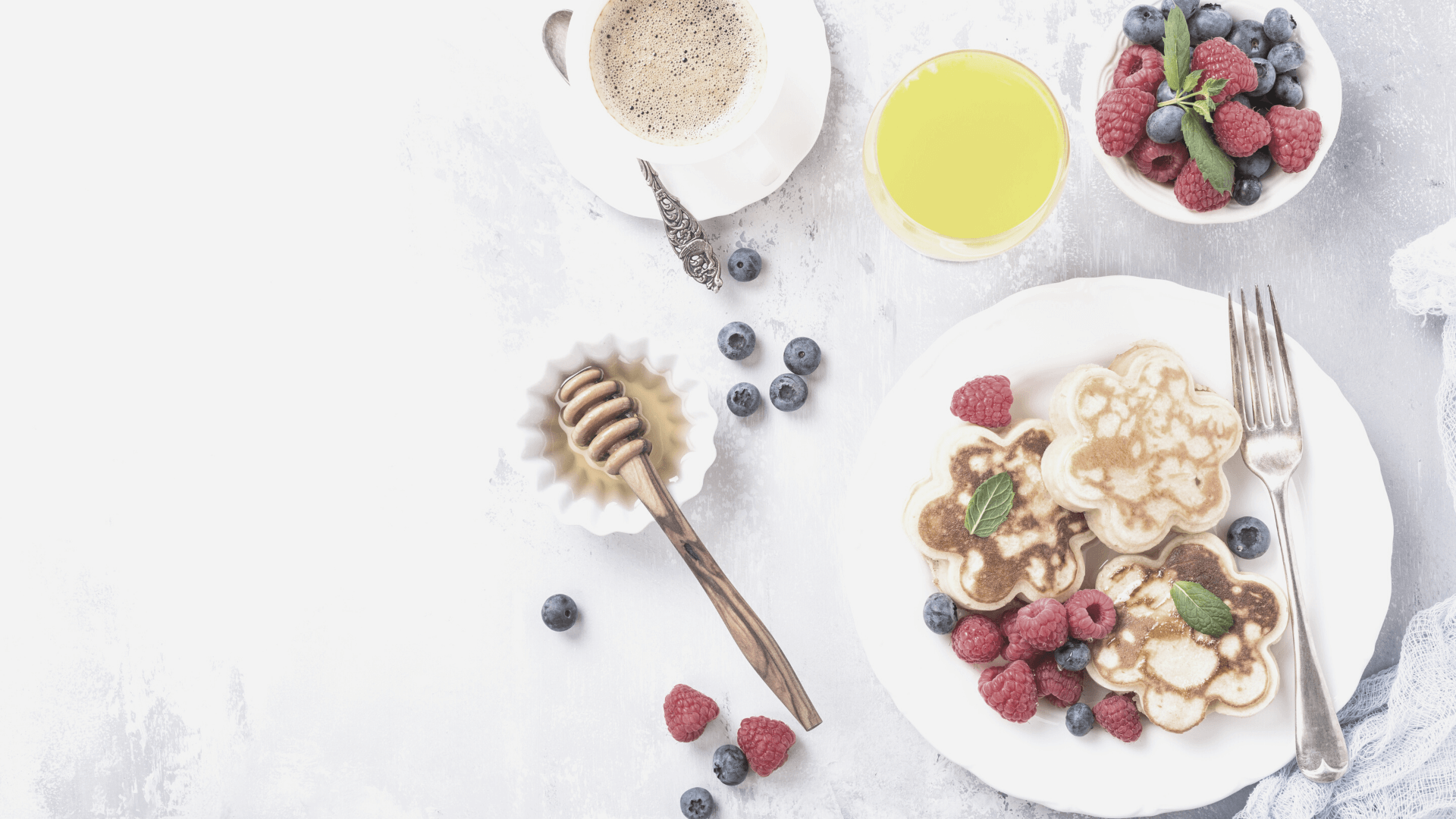
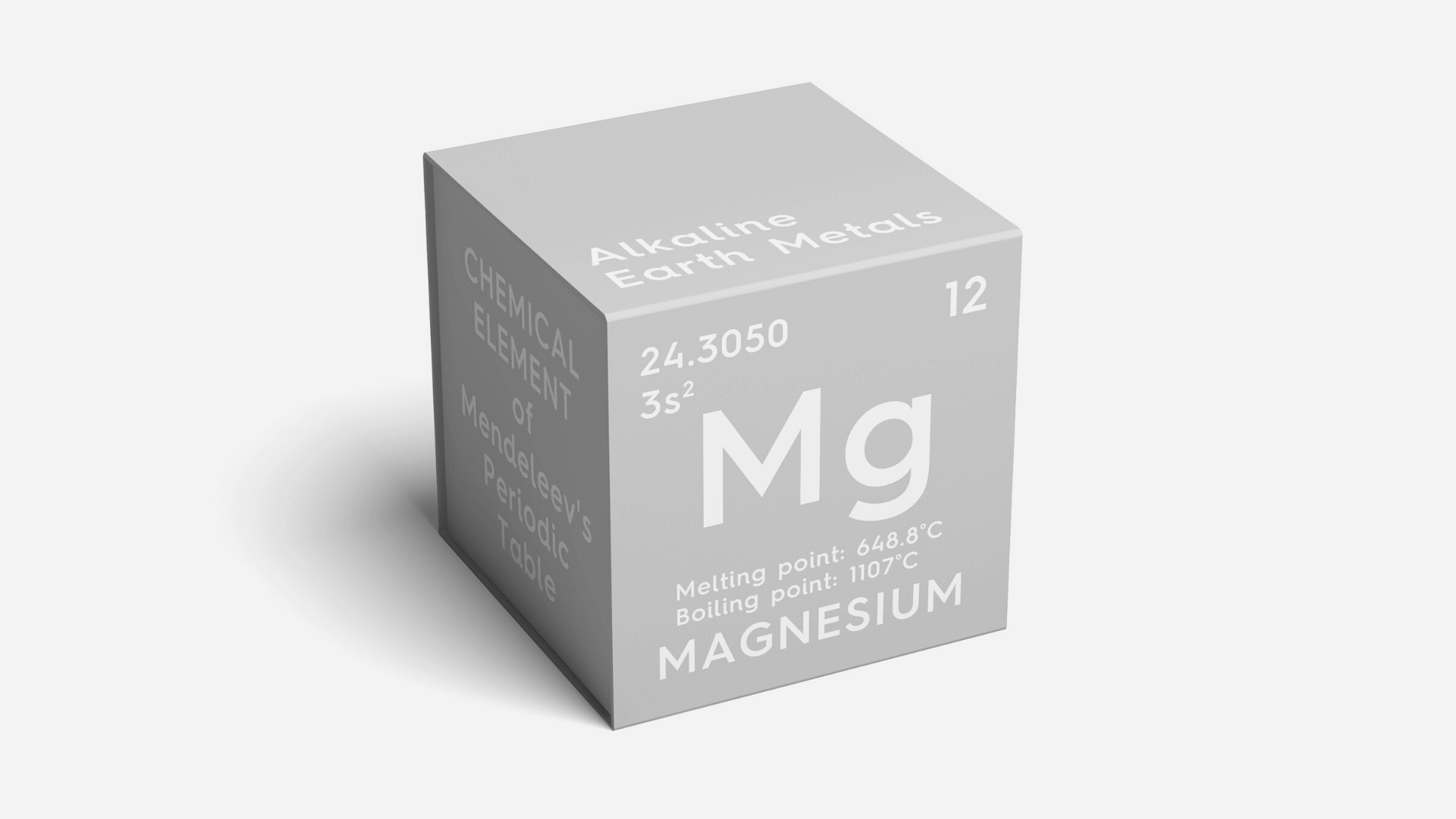
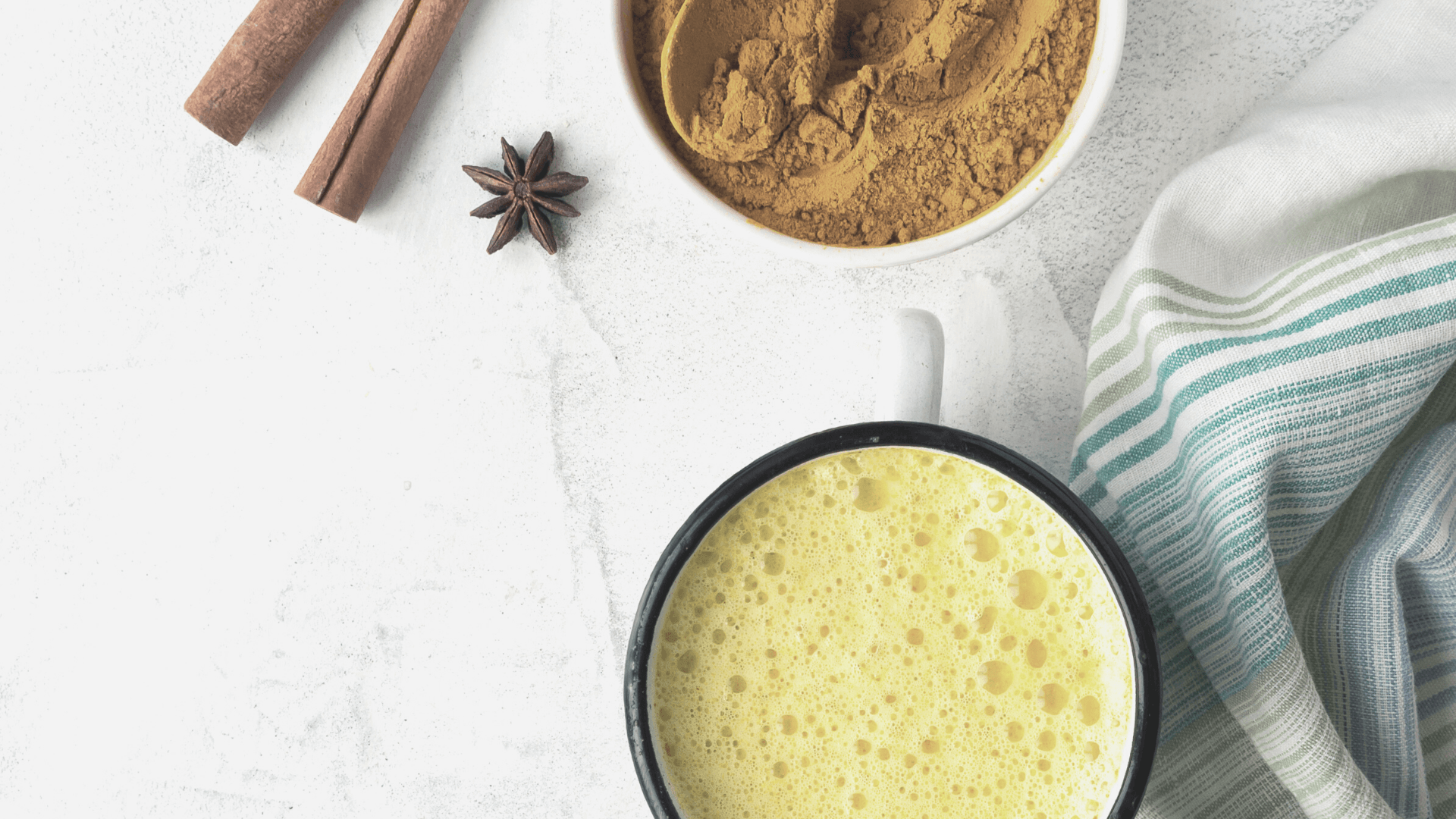
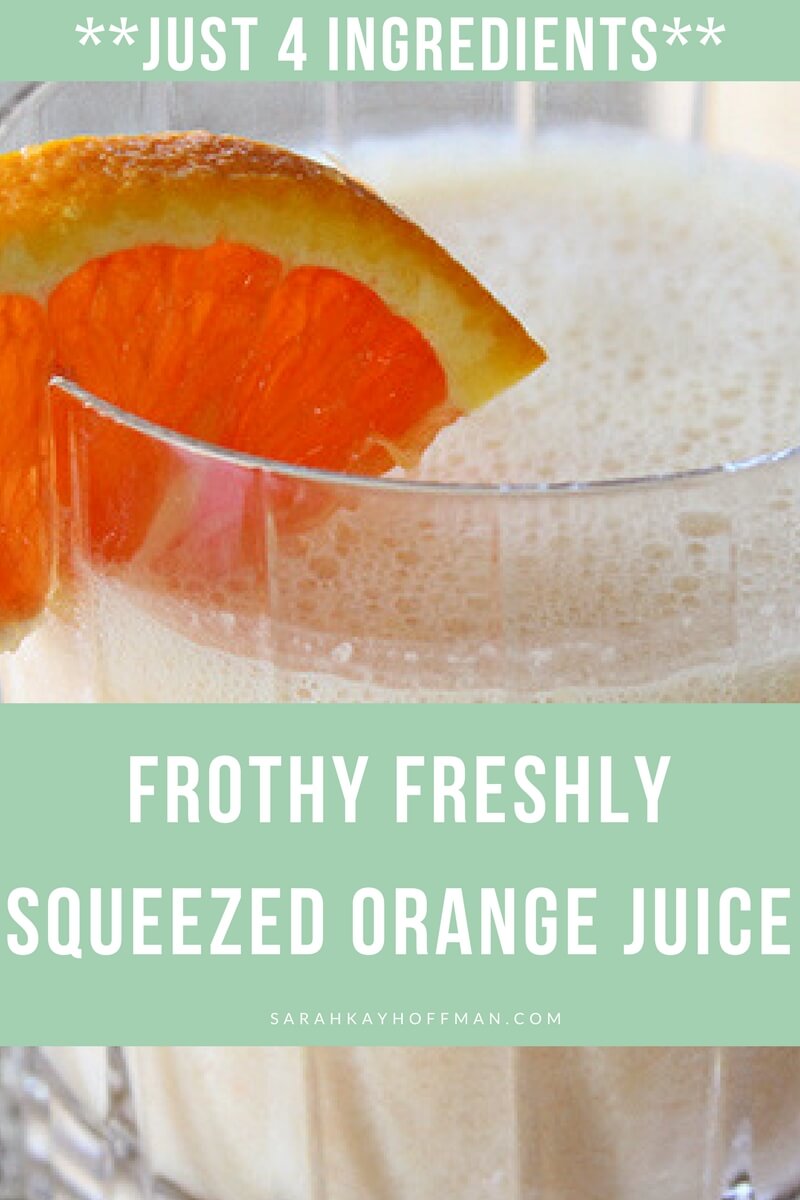
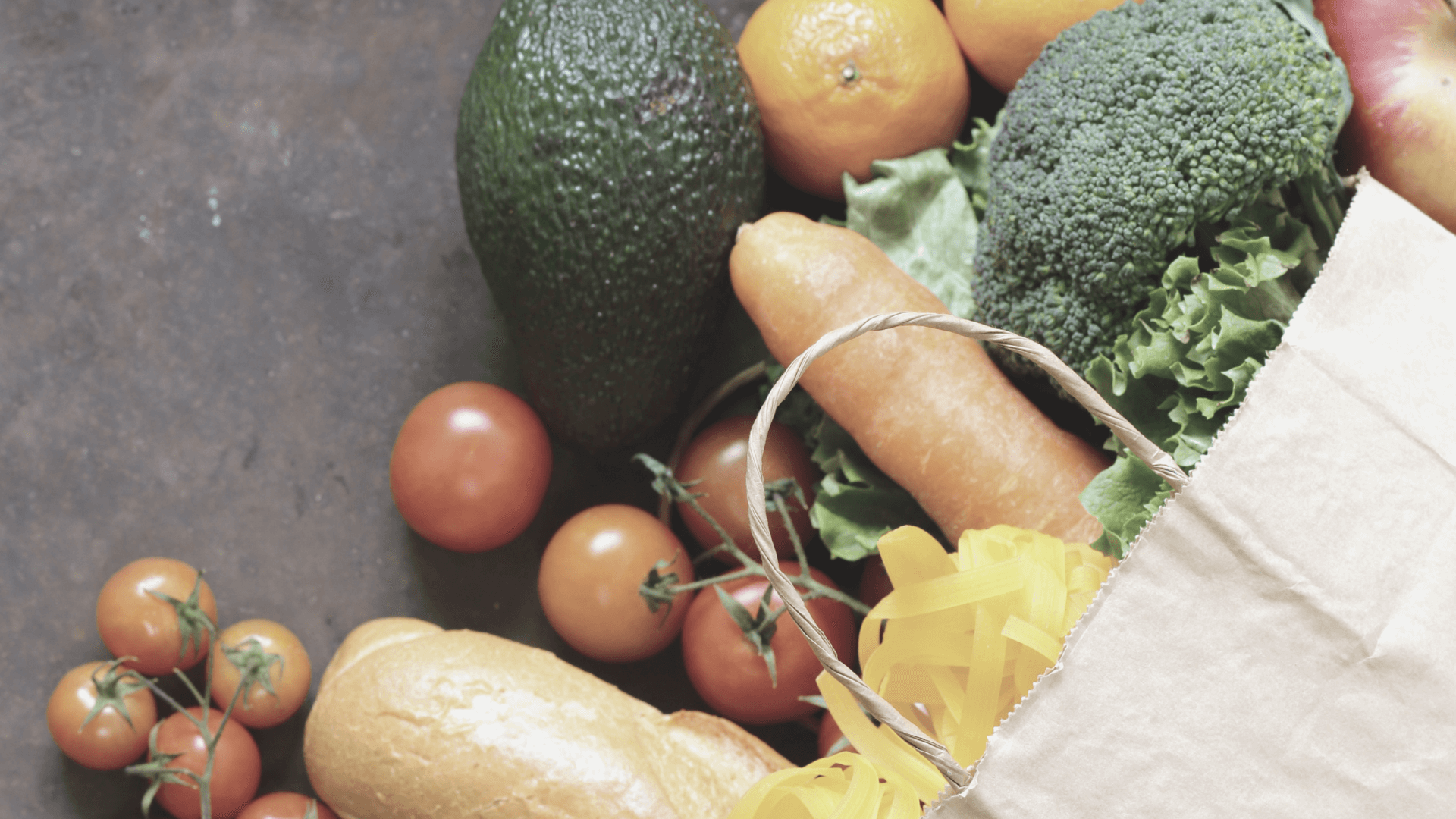

Thank you so much for those great informations !
You are most welcome!